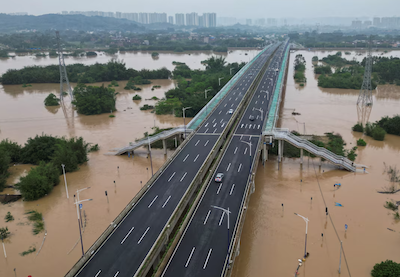Record-breaking rains have hit China’s densely populated Pearl River Delta, swamping the province once dubbed the “factory floor of the world”.
Guangdong has been battered by unusually heavy, sustained and widespread rainfall over the last week, with powerful storms ushering in an earlier-than-normal start to the province’s annual flooding season in May and June. Over the weekend, waterways in the province overflowed.
Weather events in China have become more intense and unpredictable because of global warming, scientists say, with record-breaking rainfall and drought assailing the world’s second-largest economy, often at the same time.
Precipitation records for April have been broken in many parts of Guangdong, with the cities of Shaoguan, Zhaoqing and Jiangmen to the west and north of Guangzhou also half-submerged in flood-waters.
Also on AF: Huawei’s China-Made 7nm Chip ‘Years Behind US’, Raimondo Says
The downpours have killed four people and 10 others remain missing in the province as of Monday, state-owned Xinhua News Agency reported.
Two companies, though, said there had been no immediate impact on business or supply chains.
“Everything’s running as usual and everyone got to work,” said a person who answered the phone at Camelot PCB, a print circuit board company that supplies Tesla and other electric vehicle makers.
Polyrocks Chemical, a plastics company that supplies technology giants such as Apple, Huawei and Samsung, also said its operations were not affected.
Many rivers remained swollen on Monday, however, at levels above safety thresholds, with rainfall in recent days two to three times more than normal at this time of the year.
The intense convective weather in southern China was caused by a stronger-than-normal subtropical high, a semi-permanent high pressure system circulating north of the equator.
The subtropical high led to warmer temperatures that drew in more moisture-laden air from the South China Sea and the Bay of Bengal, Chinese meteorologists said, resulting in the intense precipitation.
- Reuters with additional editing by Sean O’Meara
Read more:
Floods, Droughts, Earthquake, Big Freeze Cost China $3.3bn
China’s Hebei Province Faces Two Years of Flood Repairs
Impact of Floods in China From Typhoon Doksuri Rises
Typhoons, Floods, Heatwaves Cost China Economy $5.7bn in July
























